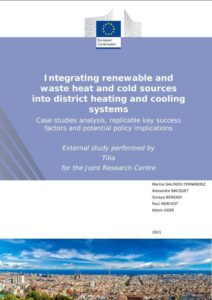This study performed by Tilia investigates the design and operation of DHC systems mainly supplied by renewable energy sources and (excess) waste heat and cold sources, aiming at identifying the key success factors enabling the integration of those sources, and drivers and conditions for their replicability in other cities and communities.
(via EU Science Hub) Based on a holistic case studies analysis of 8 efficient district heating and cooling (DHC) systems in different EU Member States (Denmark, France, Germany, Italy, Lithuania and Spain), this study investigates the design and operation of DHC systems mainly supplied by renewable energy sources and (excess) waste heat and cold sources, aiming at identifying the key success factors enabling the integration of those sources, and drivers and conditions for their replicability in other cities and communities.

This study also suggests some potential policy guidelines to support the integration of local and low-carbon energy sources through DHC. Through the analysis of concrete operational examples, the study contributes to increasing awareness on the role and features of efficient DHC systems, which have proved to be powerful levers for deep decarbonisation, providing an evolutive backbone to balanced energy transitions.